
Manhattan Beach Unified School District promotes Social Emotional Learning by celebrating “SEL Week”; commissions equity audit that recommends the school district adopt the “Social Justice Standards”
Incidents
In early March 2022, the Manhattan Beach Unified School District promoted a Social Emotional Learning (SEL) week on Twitter and Facebook. Schools in the district also hosted events to celebrate the week. The school district additionally has a page on its website dedicated to promoting SEL. On this page, the school district promotes the organization CASEL and the “five core competencies” of SEL established by CASEL:
- Self-awareness: Know your strengths and limitations, with a well-grounded sense of confidence, optimism, and a “growth mindset.”
- Self-management: Effectively manage stress, control impulses, and motivate yourself to set and achieve goals.
- Social awareness: Understand the perspectives of others and empathize with them, including those from diverse backgrounds and cultures.
- Relationship skills: Communicate clearly, listen well, cooperate with others, resist inappropriate social pressure, negotiate conflict constructively, and seek and offer help when needed.
- Responsible decision-making: Make constructive choices about personal behavior and social interactions based on ethical standards, safety, and social norms.
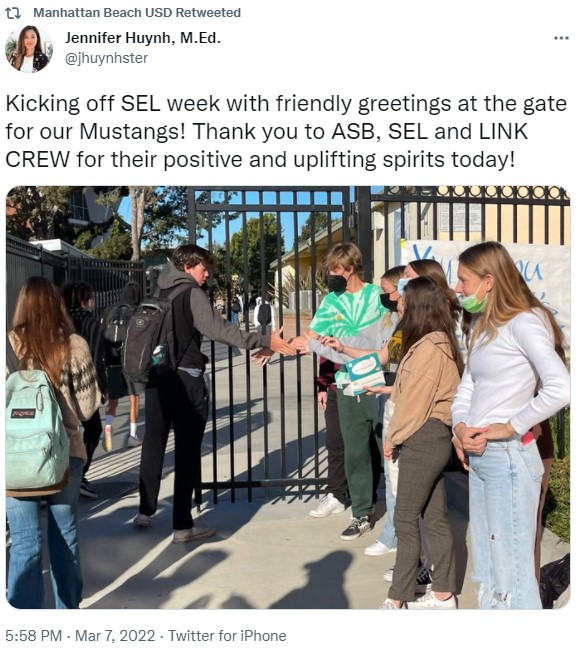


CASEL is an organization that works with school districts throughout the country to use SEL in an effort to push “equity” and “social justice” in education. On July 1, 2020, CASEL promoted “racial justice” in discussing its roadmap for reopening schools during the COVID-19 pandemic. In explaining the importance of the reopening process for schools, the organization stated that “this moment called on all members of our school communities to deepen our social and emotional competencies and create equitable learning environments where all students and adults process, heal, and thrive.” CASEL also published a video in 2020 titled “SEL As a Lever for Equity and Social Justice.”
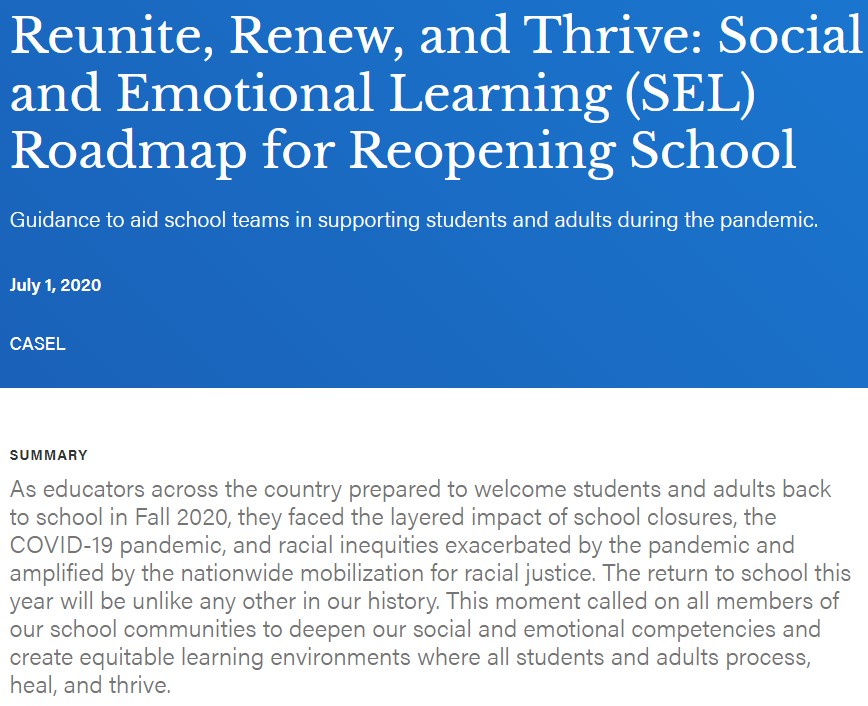
The school district’s SEL page also features a poster titled “Inclusion Stand Up Commitment” that appears to be a pledge for students. The poster states: “I commit to Stand Up against hate, prejudice, violence, and bullying and STAND UP for respect and inclusion.” The poster then states to “speak out” when someone is targeted “because of their race, ethnicity, gender, religion, ability, gender identity, or any other factor.” The poster also states to “talk about how stereotypes, prejudice, discrimination, and exclusion make people feel and how they harm our society.”
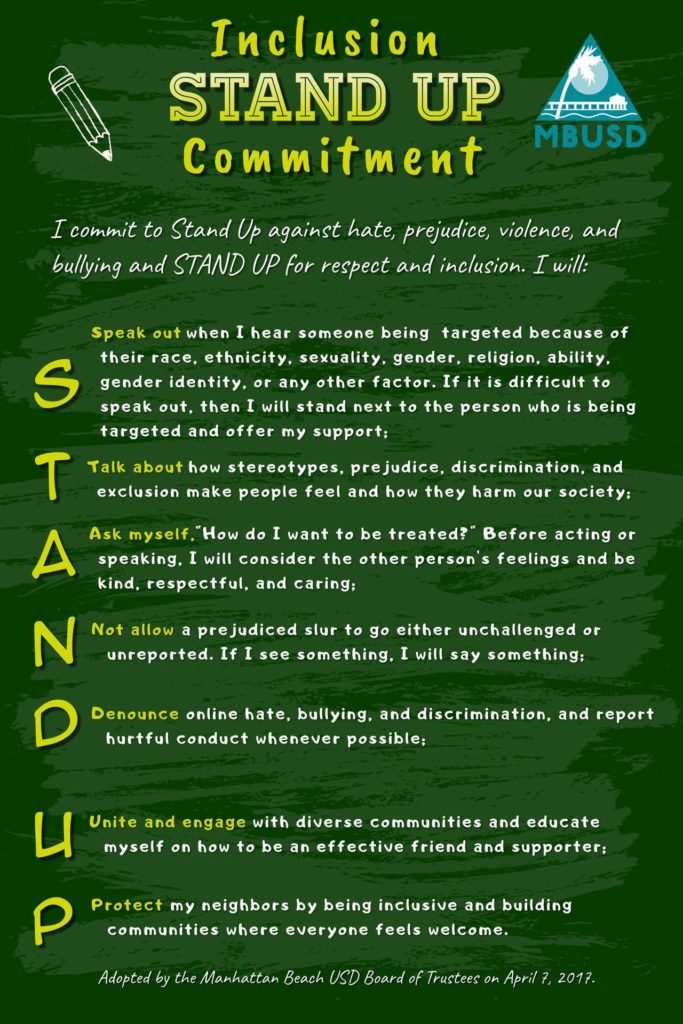
The school district has a page on its website called “Panorama Survey.” The page has links to Panorama surveys that will be given to students. One survey is titled the “Equity and Inclusion Survey.” The following are a few questions asked by the survey:
- At your school, how common is it for students to have close friends from different racial, ethnic, or cultural backgrounds?
- What do you wish your teachers knew about your experiences of race, ethnicity, or culture at school?
- What is the most important thing your school can keep doing to support students of different races, ethnicities, and cultures?




Panorama Education Inc. is known for helping schools throughout the country survey the race, ethnicity, sexual orientation, and gender identity of students in an effort to push “equity and inclusion” in school systems. The organization offers an “Equity and Inclusion Survey” to “help schools and districts track the progress of equity initiatives through the lens of students and staff, identify areas for celebration and improvement, inform professional development, and signal the importance of equity and inclusion to the community.”

The school district has a page on its website labeled “Inclusive Classroom Book Resources.” The resource page claims to have “literature supporting critical conversations on antiracism and social justice.” The page links to a document titled “Diverse Literature and Other Resources Supporting Conversations on Race, Racism, Inequality, and Social Justice.” The document provides several lists of books and resources promoting “racial justice” and other outright political causes.
The first list of books in the document is labeled “National Network of State Teacher of the Year Social Justice Book List.” Some of the books aimed at young children in this list are A is for Activist, Gracefully Grayson, and GLBTQ: The Survival Guide for Gay, Lesbian, Bisexual, Transgender, and Questioning Teens. The description of A is for Activist explains that the book “starts the conversation about our responsibility to be active in and responsive to issues of justice in our communities.” Gracefully Grayson is a book about a child who transitions to another gender.
This list also contains books for teachers including Teaching for Social Justice, This Is Not A Test: A New Narrative on Race, Class, and Education, and Culturally Responsive Teaching: Theory, Research, and Practice. The description of Teaching for Social Justice claims that the book runs “the gamut in terms of thinking and teaching about social justice issues.” The description for This Is Not A Test claims that the book is a “walk through the complicated world of educational equity, student advocacy, policy making, justice, and whose voices are and aren’t heard.” The term “culturally responsive” is also often used to describe a method of teaching that includes the race and ethnicity of students as part of the lessons taught in classrooms.
The school district’s “Diverse Literature” document also has resources for the 1619 Project. The New York Times created the controversial 1619 Project as an attempt to reframe U.S. history in a way that marks the year 1619 as the country’s foundational date because that was the first year that slaves were brought to Virginia.
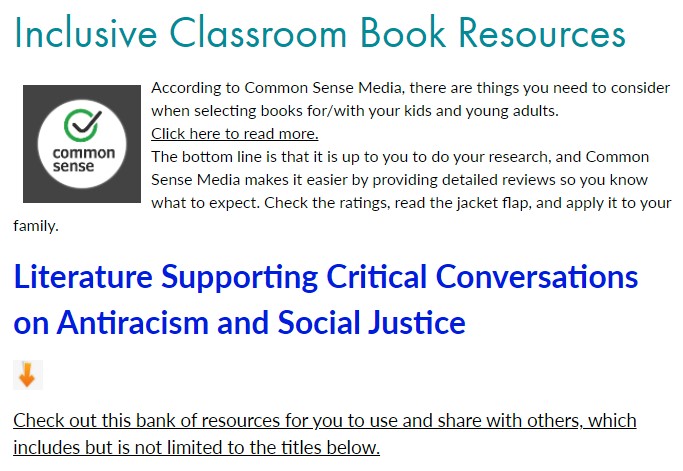
The school district’s website also has a page titled “Equity, Diversity, Social Justice, and Inclusion.” The school district states on the page that “we recognize that we have a responsibility to actively oppose racism and discrimination, and to guide this work with our students, families, and staff.” The page promotes a statement from the superintendent that was published on May 25, 2021. He states that the school district created an Equity, Diversity, Social Justice, and Inclusion (EDSJI) Committee to guide the school district in implementing equity and in altering the curriculum. He listed the following duties of the committee:
- Help facilitate discussions that explore and address bias, discrimination, micro-aggressions and stereotypes perpetuated in our district that cause systematic oppression and impact teaching practices.
- Identify ongoing professional development opportunities for all district staff, including anti-bias and anti-discrimination training.
- Discuss curriculum modifications that encourage inclusion, allow all students to feel represented, and find their voices.
- Examine and suggest revisions to reporting processes to ensure that they are fair, accessible, equitable, clear, and that they address systemic barriers.
- Assess existing disciplinary and restorative justice practices as well as potential changes to such practices to effectively address acts of racism, discrimination, and harassment in the district.
The school district commissioned the Center for Leadership, Equity and Research (CLEAR) to produce an equity audit for the district. The school district explained that “the CLEAR team will assess current practices to support MBUSD in growing equitable practices that foster a climate of care, equity, diversity, social justice, and inclusion in all MBUSD schools.” One recommendation the audit gave the school district was to “create policy around a comprehensive Cultural Competence Framework using the Social Justice Standards” from the organization Learning for Justice.
Learning for Justice has pushed for its “Social Justice Standards” to be adopted in schools throughout the country. The document for these standards includes goals to achieve for students. One goal is that “students will develop language and historical and cultural knowledge that affirm and accurately describe their membership in multiple identity groups.” Another goal appears to outright state that the purpose of the “Social Justice Standards” is to turn students into political activists: “Students will make principled decisions about when and how to take a stand against bias and injustice in their everyday lives and will do so despite negative peer or group pressure.”
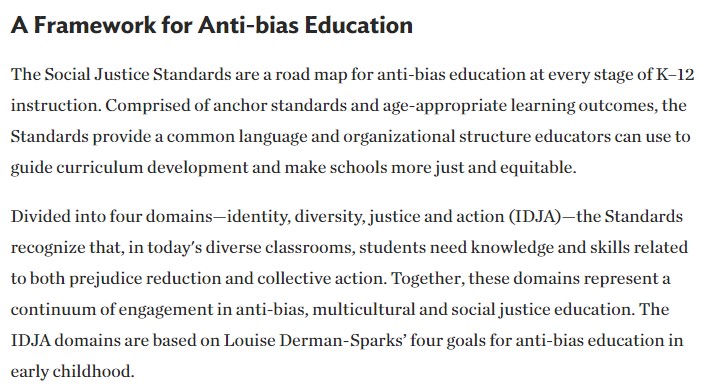
On May 5, 2021, the school district adopted a resolution titled “Denouncing All Manifestations of Hate, Xenophobia, Prejudice, and Bigotry, While Affirming MBUSD’s Commitment to the Safety and Well-Being of Our Community.” The policy states that the school district “acknowledges the importance of culturally responsive practices and inclusive policies that represent the diversity in our world and honor the contributions of marginalized communities.” The policy also states that the school district will “develop curriculum that is reflective of each student’s background and experience and classrooms that are safe spaces for students to develop and express their voices.”
In 2017, the school district adopted a resolution titled “Resolution Designating Manhattan Unified School District as an Inclusive, Safe, and Welcoming District, Ensuring a protected Space for All Students to Learn.” The resolution appears to target U.S. Immigration and Customs Enforcement (ICE) in an attempt to limit the law enforcement agency’s ability to enforce laws in the district’s schools. The policy states: “Any request related to immigration status, or by anyone tasked with registering or profiling people of a particular religion, race or ethnicity for information or to access a school site shall be immediately forwarded to the Superintendent for review and a decision on whether to allow access to the site, and/or the information to ensure District compliance with Plyler and other applicable laws.”
Stay Informed
